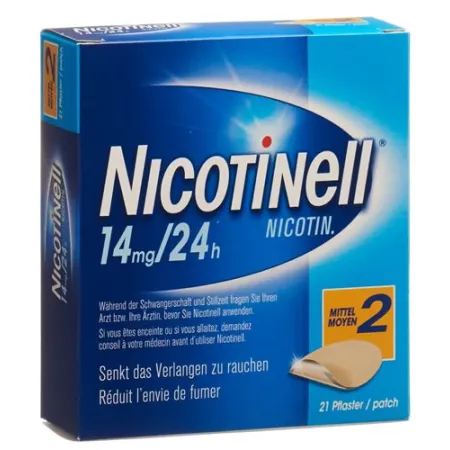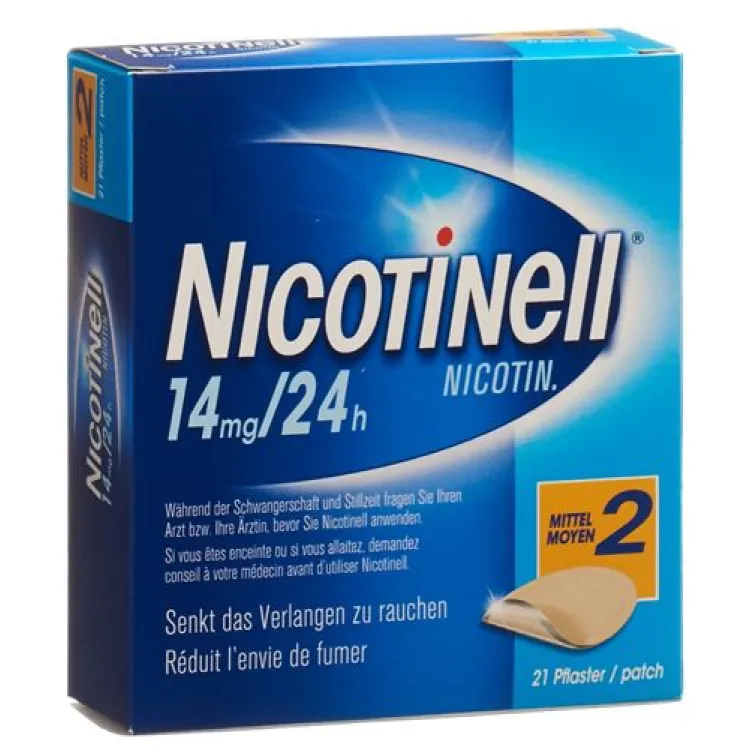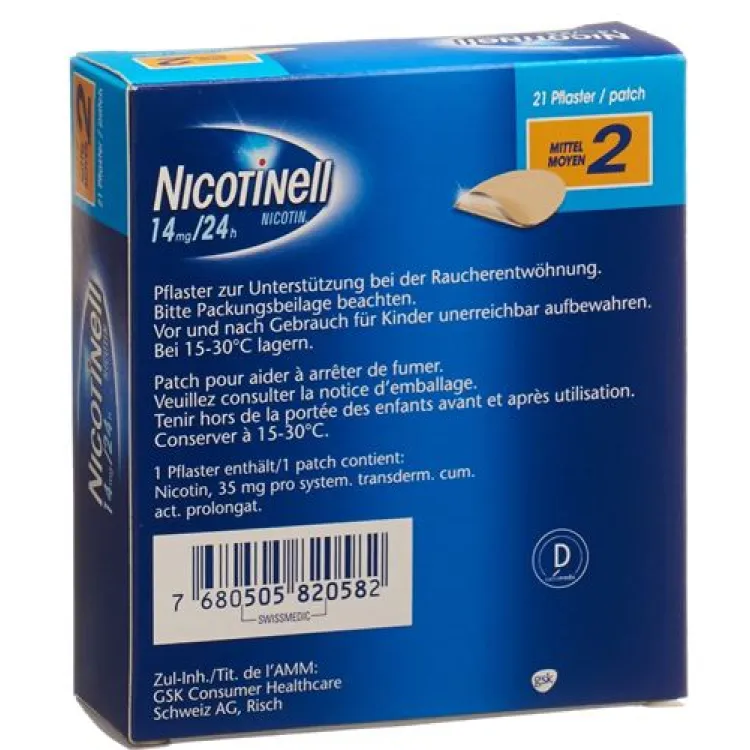Nicotinell 2 medium matrix pfl 14 mg/24h 21 pcs
Nicotinell 2 mittel Matrixpfl 14 mg/24h 21 Stk
-
253.35 CHF

- Availability: In stock
- Distributor: GSK CONS. HEALTHC. AG
- Brand: Nicotinell
- Product Code: 3229269
- ATC-code N07BA01
- EAN 7680505820582
Ingredient:
Description
What is Nicotinell Patch and when is it used?
Nicotinell Patch is recommended as a support when trying to quit smoking. Nicotinell Patch is a nicotine patch that slowly releases nicotine and absorbs it through the skin.
Nicotine is the addictive component in tobacco smoke and is responsible for the various withdrawal symptoms that occur when you quit smoking. Through the controlled delivery of nicotine through the skin using the patch, these withdrawal symptoms are reduced and it is easier for the smoker to give up cigarette nicotine.
After a while, as you develop new habits (substitutes for smoking), experience has shown that you will find it easier to gradually reduce the amount of nicotine from Nicotinell patches and later to stop completely.
Harm damage caused by the tar and carbon monoxide content in tobacco smoke, are avoided.
What should be considered?
Your motivation and willpower are decisive for the success of the treatment. If you use Nicotinell patches, you must give up smoking altogether, otherwise there is a risk of nicotine overdose. It is therefore important that you are strongly motivated to quit smoking before starting Nicotinell treatment. Professional smoking advice increases the chances of successfully quitting.
When should Nicotinell plasters not be used?
Nicotinell plasters should not be used in the following cases:
- if you are known to be hypersensitive to nicotine or one of the excipients according to the composition,
- if you have chronic skin diseases, psoriasis,
- if you have severe cardiovascular diseases, a recent stroke or a recent stroke heart attack,
- during pregnancy and breastfeeding.
- Nicotinell plasters may not be used by non-smokers, children under the age of 12 and, in principle, by young people! Adolescents under the age of 18 and over 12 should only use the preparation if they are heavily dependent on nicotine and only after consulting a doctor.
When should you be careful when using Nicotinell patches?
If you have health problems, suffer from skin diseases or one of the following diseases, you should carefully discuss the benefits and risks with your doctor before starting treatment with Nicotinell:
- Diabetes mellitus: when you start nicotine replacement therapy, you should check your blood sugar levels more frequently than usual, as blood sugar levels can fluctuate more. Drug therapy may need to be adjusted.
- Stable angina pectoris, recent heart attack, cardiac arrhythmias, heart failure (heart failure), circulatory disorders in the arms and legs (e.g. smoker's leg), diseases of the blood vessels, stroke,
- Kidney and liver diseases,
- Hyperthyroidism, pheochromocytoma (adrenaline-producing tumor of the adrenal gland),
- Inflammation of the gastric mucosa or acute gastric and intestinal ulcers, inflamed esophagus. Nicotine replacement therapy can worsen the symptoms.
- Epilepsy if you have ever had seizures.
The use of the preparation should only be considered in these cases if smoking cessation is not possible without medical support. If new cardiovascular symptoms develop or existing symptoms worsen (chest pain, irregular heart rate, shortness of breath), a doctor should be consulted
Stopping smoking with or without a nicotine replacement such as Nicotinell patches may alter the response to concomitant medicines for asthma, cardiac arrhythmia, severe pain, mood disorders, Alzheimer's disease, stomach and intestinal ulcers, or diabetes (insulin). If necessary, your doctor will prescribe an adjustment of the dose of the affected medicines.
Nicotinell patches contain aluminium:
The patch should be removed during an MRI scan, electrical defibrillation and diathermy treatment.
Inform your doctor, pharmacist or druggist if you suffer from other diseases, have allergies or are taking other medicines (including those you have bought yourself!) use.
There is no evidence of any risk to the ability to drive or use machines as long as the recommended dosage is followed. However, be aware that behavioral changes may occur when you quit smoking.
Can Nicotinell patches be used during pregnancy or breast-feeding?
It is very important that you completely stop smoking during pregnancy, as this can lead to stunted growth in your child.
If you are pregnant, you should try to quit smoking without using any medicines. Nicotine in any form can harm the unborn child.
During pregnancy or breastfeeding, no form of nicotine should be taken, not even with Nicotinell patches. Nicotine passes into breast milk.
Talk to your doctor about how you should quit smoking during this time.
How do you use Nicotinell patches?
Once you start treatment with Nicotinell patches, you should stop smoking completely.
Nicotinell patches are intended for adults aged 18 and over.
Adolescents under 18 and over 12 years of age The preparation should only be used if you are heavily dependent on nicotine and only after consulting a doctor (see also «When should Nicotinell plasters not be used?».
Nicotinell plasters are available in three strengths:
Nicotinell plasters 1 strong (21 mg/24h, 52.5 mg nicotine)
Nicotinell plasters 2 medium (14 mg/24h, 35 mg nicotine)
Nicotinell Patch 3 light (7 mg/24h, 17.5 mg nicotine)
The strength that applies to you is determined on the basis of the cigarettes you smoke per day or using the Fagerström test. This test measures the level of your nicotine dependency. Based on your score on this test, you will be able to choose the most suitable patch strength for you.
To estimate your level of nicotine addiction, please use the Fagerstrom test.
Fagerstrom test
Your score | ||
|---|---|---|
- up to 5 minutes | = 3 | |
- 6 to 30 minutes | = 2 | |
- 31 to 60 minutes | = 1 | |
- after 60 minutes | = 0 | |
Do you find it difficult not to smoke in places where smoking is prohibited? | ||
- yes | = 1 | |
- no | ||
Which daily cigarette would you not want to do without? | ||
- the first | = 1 | |
- another | = 0 | |
How many cigarettes do you smoke a day? | ||
- 10 or less | = 0 | |
- 11 to 20 | = 1 | |
- 21 to 30 | = 2 | |
- 31 or more | = 3 | |
Do you smoke more often in the morning than in the afternoon? | ||
- yes | = 1 | |
- no | = 0 | |
Do you smoke when you are sick and have to stay in bed most of the day? | ||
- yes | = 1 | |
- no | = 0 | |
Total number of points | ||
Evaluation of the Fagerstrom test
- Score from 0 to 2: You are not addicted to nicotine. You can quit smoking without nicotine replacement therapy. However, if you are concerned about quitting smoking or are unsure about how to choose the patch strength, consult your doctor, pharmacist or druggist.
- Score from 3 to 4: You are mildly addicted to nicotine.
- Score from 5 to 6: You are moderately addicted to nicotine. Nicotine replacement therapy increases your chances of success. Let your doctor, pharmacist or druggist advise you on the most suitable treatment for you.
- Score from 7 to 10: You are heavily or very heavily dependent on nicotine. To overcome your nicotine addiction, nicotine replacement therapy is recommended. It must be used in a sufficient and appropriate dose. Ask your doctor, pharmacist or druggist for advice, if possible as part of a special consultation on stopping smoking.
The degree of nicotine dependence must be determined based on the number of nicotine smoked dailycigarettes or using the Fagerstrom test for nicotine dependence.
1. month | 2. month | 3. month | |
|---|---|---|---|
More than 20 cigarettes per day(5 or more points on the Fagerstrom test) | Level 1 (strong) | Level 2 (medium) | Level 3 (light) |
Less than 20 cigarettes per day (less than 5 points in the Fagerstrom test) | Level 2 (medium) | Level 2 (medium) | Level 3 (light) |
The total treatment with Nicotinell patches should last a maximum of 3 months!
Type of application:
Each Nicotinell patch is individually sealed in an airtight child-resistant sachet. Use scissors to cut open the child-resistant pouch along the outer edge and remove the patch (Fig. 1). After removing the cut edge of the aluminium-colored protective liner (Fig. 2), hold the patch by the protruding edge and slowly peel off the aluminium-colored liner from the cut point without touching the adhesive layer (Fig. 3).
Apply one Nicotinell patch daily, preferably when you get up, and leave it on the skin for 24 hours.
Place the patch on a healthy, hairless, dry and clean area of skin (no lotion, no alcohol, no ointment residue, etc.), preferably on the trunk or upper arm (inside or outside) (Fig. 4-6). The plaster should be pressed with the heel of the hand for about 10-20 seconds over its entire surface. It should not be applied to a red, bruised or irritated area of skin. Wash your hands carefully afterwards so that no nicotine from your fingers gets into your eyes.
The Nicotinell patch will now remain on the skin for 24 hours.
Afterwards, peel off the patch and fold it with the sticky side inwards. Since the patches still contain nicotine after use, they must be disposed of in such a way that they cannot get into the hands of children.
Now stick a new patch on a different area of skin. To avoid local skin irritation, the same area of skin should be used again after 7 days at the earliest. Nicotinell Patch adheres well to the skin and remains functional even when bathing, showering or exercising.
If you ever forget to change Nicotinell Patch at the allotted time, don't worry. Make up for the patch change as soon as possible and apply the next patch at the usual time.
If you start smoking again while you are being treated with Nicotinell patches, the treatment should be discontinued. You can try to stop using Nicotinell patches at a later time.
Dosage adjustment cannot be made by cutting a patch. Never use more than one Nicotinell patch at the same time.
Stick to the dosage given in this leaflet or as prescribed by your doctor. If you think the medicine is too weak or too strong, talk to your doctor, pharmacist or druggist.
What side effects can Nicotinell patch have?
Stop using Nicotinell (remove the patch) and tell your doctor immediately if you experience any of the following symptoms, which are signs of a rare serious allergic reactionmay be:
- Allergic reactions such as skin swelling,
- swelling of the face, lips, tongue or throat,
- low blood pressure and difficulty breathing.
Certain symptoms, such as irritability, nervousness, restlessness, mood swings, depressed mood, feelings of depression, anxiety, drowsiness, difficulty concentrating, insomnia and sleep disorders may be due to Ent symptoms related to smoking cessation. People who quit smoking by any means may experience headaches, drowsiness, coughing or flu-like symptoms.
Some side effects are very common (may affect more than 1 in 10 people):
Reactions at the application site, such as itching, redness, edema and a burning sensation. If you get a serious skin reaction that does not go away, you should stop using the product and consult your doctor, pharmacist or druggist to find you another form of nicotine replacement therapy.
Application site reactions are partly caused by not changing the patch application site every day. Rotating the application site daily allows irritation to decrease naturally and should cause less discomfort.
Some side effects are common (may affect up to 1 in 10 people in 100):
Headache, nausea, dizziness, trouble sleeping including abnormal dreams, insomnia, nervousness, cough, sore throat, abdominal pain, upset stomach, muscle pain.
These side effects are usually mild and will go away quickly on their own once you stop using this removed patches.
Some side effects are uncommon (may affect up to 1 in 10 people in 1,000):
Tingling sensation, palpitations, vomiting, constipation, diarrhea, gas, dry mouth, excessive sweating, joint pain, weakness, pain at the application site, feeling unwell, flu-like symptoms.
Some side effects are rare (may occur with 1 to 10 in 10,000 people):
Trembling, shortness of breath, cardiac arrhythmia.
Some side effects are very rare (less than 1 in 10,000 people):
Allergic inflammatory skin disease, contact dermatitis, photosensitivity.
Aphthous ulcers can occur when you stop smoking, the reason is unknown.
If you notice side effects , contact your doctor, pharmacist or druggist. This also applies in particular to side effects that are not listed in this leaflet.
Overdose:
An overdose and thus nicotine poisoning can also occur in adults if, for example, several patches are used together or if nicotine from tobacco is consumed at the same time. In the event of an overdose, the signs correspond to those of acute nicotine poisoning. The following occur: nausea, salivation, abdominal pain, low temperature, diarrhea, sweating, headache, dizziness, hearing disorders, confusion, paleness and pronounced weakness. In extreme cases, the following can occur: spasms, drop in blood pressure, weak, irregular pulse, respiratory failure and fainting, circulatory collapse.
In the event of an overdose or suspected overdose, the nicotine patch must be removed immediately and the application site rinsed with water and dried (do not use soap). Consult a doctor immediately. Even small amounts of nicotine are dangerous for children and can lead to severe symptoms of poisoning, which can be fatal. If you suspect nicotine poisoning in children, you must seek medical help as soon as possible.
What else needs to be considered?
Special warning for children
Keep medicines out of the reach of children. Nicotine is a highly toxic substance. Even the dose that adults can tolerate during treatment can lead to severe poisoning in small children, i.e. sticking Nicotinell patches on playfully can be fatal for children if not noticed in time. That is why the Nicotinell patches must be kept out of the reach of children at all times.
The patches still contain nicotine even after use! Therefore, fold the removed plasters with the adhesive layer inwards and dispose of them so that they cannot get into the hands of children.
Storage instructions
Store at 15-30 °C.
Keep out of the reach of children.
The medicinal product may only be used up to the date marked "EXP" on the container.
Further information
Your doctor can provide you with further information , pharmacist or druggist or your doctor, pharmacist or druggist. These people have the detailed technical information.
What does Nicotinell Patch contain?
Active substance
Nicotine.
Excipients
Nicotinell Patch is a Ttransdermal Ttherapeutic Ssystem (TTS).
Contains 1 Nicotinell Patch 1 (strong). 52.5 mg nicotine. TTS 30 with 30 cm2 absorption area.
Average active ingredient release on the skin 21 mg/24 hours.
Round, yellow-ochre-colored transdermal patch, protective foil marked with the code «EME».
1 Nicotinell Patch 2 (medium) contains 35 mg nicotine. TTS 20 with 20 cm2 absorption area.
Average active ingredient release on the skin 14 mg/24 hours.
Round, yellow-ochre-colored transdermal patch, protective foil marked with the code «FEF».
1 Nicotinell Patch 3 (light) contains 17.5 mg nicotine. TTS 10 with 10 cm2 absorption area.
Average active ingredient release on the skin 7 mg/24 hours.
Round, yellow-ochre-colored transdermal patch, protective film marked with the code «CWC».
Authorization number
50582 (Swissmedic).
Where can you get Nicotinell patches? Which packages are available?
In pharmacies and drugstores, without a doctor's prescription.
Nicotinell plaster 1 (strong) 21 mg/24h: 7 and 21 depot plasters.
Nicotinell plaster 2 (medium) 14 mg/24h: 7 and 21 depot plasters.
Nicotinell plaster 3 (light) 7 mg/24h: 7 and 21 depot plasters .
Authorization holder
GSK Consumer Healthcare Schweiz AG, Risch.
This leaflet was last checked by the drug authority (Swissmedic) in June 2019.





